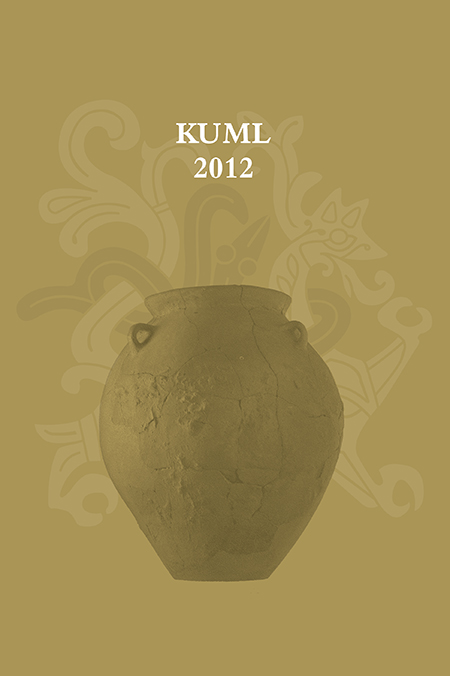“Vikinger”, vikingetid og vikingeromantik
DOI:
https://doi.org/10.7146/kuml.v61i61.24501Keywords:
vikinger, vikingeromantikAbstract
“Vikings”, the Viking Age and Viking Romanticism
The aim of this article is to take a critical look at the term “Vikings”, both as it was used in the time now referred to as the Viking Age, and as it is used today. It will also examine the degree to which Scandinavian activity during the Viking Age can justify this name being given to the epoch.
With regard to the term “Vikings”, it is pointed out that, from the term’s earliest known occurrence in Anglo-Saxon glossaries around AD 600 up until some point in time around 1300 when it seems to disappear from the Anglo-Saxon and Scandinavian languages, with Icelandic as a possible exception, it was unequivocally used in reference to pirates. In this respect it had no ethnic or geographic connotations but could, in Anglo-Saxon or Norse sources, be used in reference to anyone who behaved as a pirate, anywhere: Israelites crossing the Red Sea, Muslims encountering Norwegian crusaders in the Mediterranean, Caucasian pirates, Estonian and Baltic pirates in the Baltic Sea. Accordingly, a “Viking” was, in the earliest sources, not yet synonymous with a Scandinavian.
Furthermore, those who have attempted to derive an etymology for the word have omitted to take into consideration that at an early stage – in the first centuries AD – it was borrowed into Slavonic with the meaning: hero and warrior. Consequently, these attempts were unsuccessful.
After having disappeared as a living word, it subsequently emerged from obscurity when Danish and Swedish historians began to compete with respect to creating the most glorious past for their respective countries and, in the process, became aware of the Icelandic sagas as a possible source. However, these historians no longer understood Old Icelandic and had to have the texts translated. The year 1633 saw the first major translation into Danish of Snorri’s Heimskringla. It is apparent from this that the translator was convinced his readers would not know what a “Viking” was. Consequently, explanatory additions were inserted at virtually all its occurrences. These clearly demonstrate that, for the translator, the word still meant pirate and was, as yet, still not synonymous with a Scandinavian.
A “Viking” first became a Scandinavian with the advent of Romanticism, primarily thanks to the two Swedish poets Erik Gustaf Geijer (1783-1847), with the poem Vikingen, and Esaias Tegnér (1782-1846), with his new version of the Old Norse Friðþjófs saga hins frœkna. With the publication of these two works “Viking” became for the first time a household word and was now used exclusively in reference to Scandinavians; with this meaning it rapidly spread to other languages. Around the middle of the 19th century the word also began to be used in this sense by archaeologists and historians.
Soon the word “Viking” also became linked with the term for a period, the Viking Age, a period which was characterised by increasing Scandinavian activity outside Scandinavia. As the archaeological evidence could not, at that time, yet be dated with any precision, it was the evidence from written sources with respect to attacks on monasteries in the British Isles towards the end of the 8th century AD which, just as is still the case, came to mark the beginning of the Viking Age. While the written sources are today more or less the same as they were in the 19th century, the archaeological record continues to expand rapidly and the potential for dating is constantly being refined. As a consequence, we now know that Scandinavians were active both in the British Isles to the west and along the East European rivers long before the attacks on the above-mentioned monasteries.
Although the activities of Scandinavians in the east have never played a major role in general Viking studies, it is perhaps there that they had their most radical consequences for posterity.
Dendrochronological dates now show that Scandinavians settled at Staraja Ladoga around AD 750 from where, at an early point in time, they continued along the Volga towards the Caliphate. Later, however, towards the end of the 9th century, the route along the Dnepr to Byzantium became of greater importance. It was here that Scandinavians, known as “Rus”, by establishing military bases intended to safeguard the trade route and, by forging alliances with the local populations, established the principality to which they gave their name and which subsequently became Russia: Undoubtedly the most marked consequence of Scandinavian activity during the Viking Age.
These trade-related bases, together with several rapidly growing trading places in the Scandinavian and Baltic areas, were part of a major long-distance trade network which conveyed goods between east and west. A characteristic feature of these trading places was that, apart from the local population, Scandinavians were the only group to be represented at more or less all of them. It seems that this long-distance trade network was based around Scandinavians. If justification is to be found for Scandinavian activity giving its name to an epoch in European history it must be in the form of this long-distance trade network, rather than war and plunder. At the same time, the temporal boundary for this period should be shunted back to the early 8th century.
It is clear that our use of the term “Vikings” in reference to Scandinavians of that period is erroneous. In principle it should, in a research perspective, be abandoned in favour of “Scandinavians” or narrow contemporaneous ethnically- or geographically-based terms. But is this possible given that “Viking” has today become one of the most successful brands for Scandinavians and Scandinavia, and with powerful associated commercial interests?
John Lind
Center for Middelalderstudier
Syddansk Universitet
Downloads
Published
How to Cite
Issue
Section
License
Fra og med årgang 2022 er artikler udgivet i Kuml med en licens fra Creative Commons (CC BY-NC-SA 4.0).
Alle tidligere årgange af tidsskriftet er ikke udgivet med en licens fra Creative Commons.


